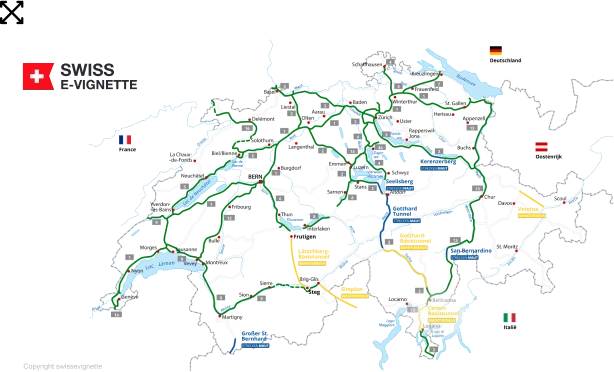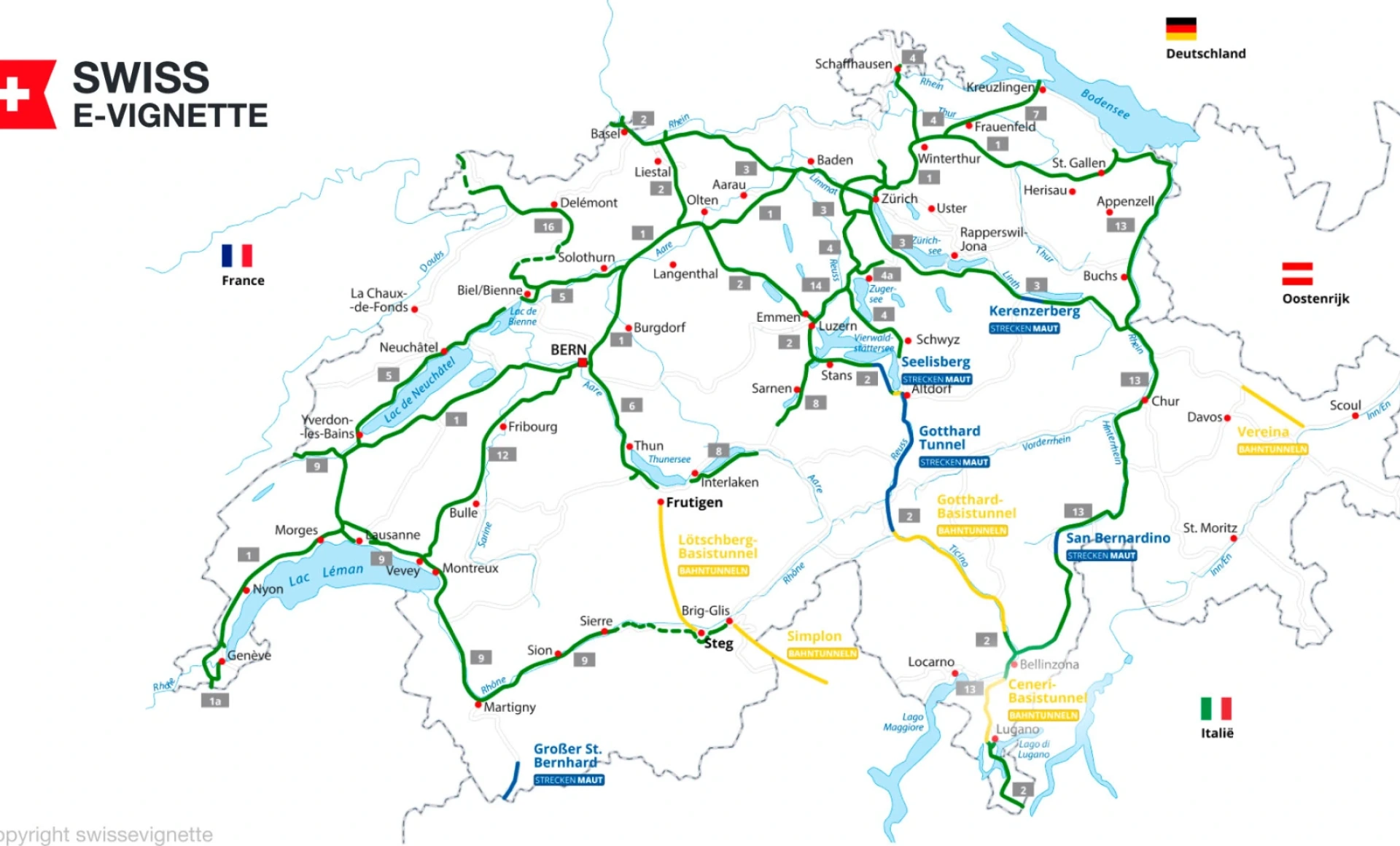Due to maintenance orders placed after 11 PM CEST will not be processed until the next day at 6 AM. If you travel before 6 AM we recommend to buy a physical sticker.
Road network Switzerland - Everything you need to know
Switzerland is located in the centre of Europe and borders several countries. Neighbouring countries include Germany, France, Italy, Austria, and Liechtenstein. The country's location is one of the reasons why Switzerland is often used by drivers to reach one of the surrounding destinations when coming from .

Road designations
So, if you are going on a trip and driving through Switzerland, you should know some important rules about the local road network. The system differs not only in terms of numbering from the network as it is known in country. There are also differences in terms of designations, speeds, and general traffic infrastructure. We have collected the most important information about the local infrastructure and created an overview with all details about the roads.

Road network Switzerland with a detailed map
First, it should be noted that Switzerland is divided into a total of 26 cantons. Cantons are roughly comparable to the country federal states. If you take this division into account, it is easier to get an overview of the road network in Switzerland. Until the 1950s, it was the cantons that were responsible for managing the roads. It was only a few years later that the federal government also became involved in this task for the first time.
Road infrastructure
What is visible on the map below is also confirmed by official statistics: Switzerland's road network is extremely well developed in almost all regions of the country and compares favourably with other countries. It is mainly the areas around Zurich, Solothurn, Bern, Basel, or St. Gallen that have a particularly dense network.
On the map, you can also see that the individual roads are subdivided. We will go into this in detail later. Some important new roads can also be seen in the overview and will be described in more detail later.
The Swiss road network explained
We mentioned earlier that there are several parties responsible for the country's road network in Switzerland. A large part of the responsibility still lies with the municipalities and cantons. However, since 1998, the Federal Roads Office (Astra) has also been considered an important authority for maintaining and expanding the national road network.
If you want to understand the system in Switzerland, you need to be aware of the following difference. As far as the country's transport infrastructure is concerned, a distinction is made between different types of roads. This means, for example, the motorways and motor roads that are part of the national road network, as well as cantonal road sections. The latter are, for the most part, shorter feeder roads to the motorways. We will cover the differences one by one later on in this article.

How many roads does Switzerland have?
How many roads there are in Switzerland in total is difficult to determine because of the different numbering and the division between national and cantonal roads. In addition, some stretches of roads are still under construction or not yet fully operational.
What is certain, however, is that according to a survey in 2020, there are a total of 26 stretches of road that are officially considered national roads in the country.
Road Network Switzerland - Length & Infrastructure
As far as the length of all roads in Switzerland is concerned, the Federal Roads Office (Astra) has published the following data for the year 2022: The road network most recently consists of a network length of more than 84.600 kilometres. This means that the network covers one-third of the country's settlement area. Motorways occupy about 1500 kilometres, and cantonal roads about 17.200 kilometres. Compared with the road network, the Swiss rail network "only" covers about 5300 kilometres.
It is also impressive that the road network has grown by about 500 kilometres in the last year alone. This is an advance that illustrates why Switzerland's many routes are also able to hold their own in an international comparison.

Road Network Switzerland
- Categories
Any road that carries significance for the entire country can be considered part of the national road network in Switzerland. The most important category is the motorway, which is especially important for drivers who use Switzerland as a transit country. The national roads are divided into three different classes. On the other hand, there are cantonal roads as well as municipal roads.
National roads
The country's national roads include motorways, motor roads, and main roads. For a better overview, the routes were originally given an N number. Today, this designation is only used by the authorities and does not indicate which category the route in question belongs to. For this purpose, the A numbering of motorways and motor roads is used. In addition, they are subdivided into classes.
The characteristic of first-class roads is that the sections have directionally separated lanes. They have up to seven lanes (4+3) and in most cases have parking lanes. Accordingly, national motorways belong to this category.
The longest motorway in Switzerland is the A1, which runs from Geneva via St. Gallen and ends in St. Margrethen. Thus, it represents a connection in the French part of Switzerland and leads to the Austrian border (east-west direction).
The A3 is a motorway that plays an important role, especially for drivers from France. It is considered a continuation of the A35 autoroute and passes Zurich in the southwest.
Like the vignette, different tickets are available for the digital route toll. Some are valid for single trips and others can be used as a yearly pass for 365 days.
Drivers can pay tolls at service stations, rest stops, or in the ASFINAG online shop before they travel. Travellers who pay the digital route toll via our portal can use the tickets immediately. Various credit cards (Visa, Diners Club, etc.) and other means of payment are accepted. The confirmation with a link will be sent to the e-mail address provided.
The Austrian infrastructure company ASFINAG also offers drivers the option to pay afterwards. This works by using the FLEX service. The trips through the toll booths on the motorways and expressways are automatically recorded via the vehicle’s license plate number and charged retrospectively.
Cantonal roads
As you can already tell from the name, these routes lie under the responsibility of the respective canton. Among the cantonal roads, there are also motorways, motor roads, main roads, and secondary roads. For this reason, the distinction between the national roads is not always clear. Most of the routes are located near the centres of Bern, Zurich or Valais. One of the biggest differences between the national motorways and motor roads described above is that no vignette is required for the cantonal routes.
Municipal roads
Main and secondary roads that are administered by a municipality are referred to accordingly as municipal roads. They lead from one town to the next and are mainly used by the locals. According to the road network, they are followed only by private roads.
The expansion of the road network in Switzerland
We already mentioned that some sections of the road network in Switzerland are still in the process of completion. There is not only one region, but many places in the country where the current construction projects can be seen. One of them is the construction of a second tube on the Gotthard tunnel described earlier. The work will continue until 2029. Since the original tunnel is now ageing, another tube will guarantee that the route can be used by travelers even during maintenance. As things stand, the road tunnel is not the only place in Switzerland where a major construction project is taking place. Many motorway junctions and sections in central, western and northern Switzerland are also being upgraded in order to constantly maintain and expand the network that currently exists.
Speeds
An important piece of information about the road network is, of course, to pay attention to the speed limits on the motorways and motor roads. In contrast to country, a maximum speed limit on the motorways in Switzerland applies. This is 120 km/h for passenger car drivers - if not stated otherwise. On motor roads, the limit is 100 km/h. Outside of towns and municipalities, the maximum speed limit is 80 km/h, and inside built-up areas, the maximum speed limit is 50 km/h. For caravans or vehicles with trailers, other regulations may apply.


Obligation to pay tolls and have a vignette
In Switzerland, vignettes are compulsory on all national roads operated by the federal government. However, the principle behind this differs in some respects from what applies in surrounding countries.
For example, vignettes for different time periods are not available - in Switzerland, only a yearly vignette is available against payment of a flat fee (currently about 41 euros). Since 1 August 2023, it has been possible to buy the vignette for Switzerland digitally. Anyone who needs a vignette must visit the sales points near the border or pre-order it online via our platform.
There are currently only two places in Switzerland where a special toll is due. At the Great Saint Bernard and the Munt la Schera tunnel, additional fees are charged. With the revision of the system, this may change. For example, it is possible that a fee will soon have to be paid for the use of additional tunnels (for crossing the Alps). The neighbouring country of Austria, for example, with its special toll routes, could be considered a model for the changes.
